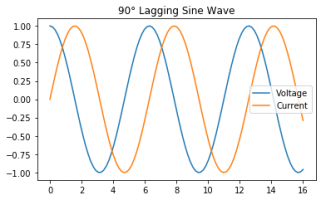View attachment 25629
So, in the image, the current lags the voltage by 90°. This is a completely inductive load. If we calculate the power (V * A for each time increment):
View attachment 25631
The power is therefore a resulting sine centered at 0W. The average of this sine is therefore 0 watts, so there's no actual dissipation
in the device, despite all the current flowing. Note that you will still get losses in the wiring, as you still have the current flowing, it's just basically fed back into the mains continuously.
The same is true for a capacitive load. It just leads to the current
leading the voltage by 90°, instead of lagging.
View attachment 25633
If we take a device with 0° phase offset between the current and voltage:
View attachment 25632
You can see the power never goes negative, so you have "true" power dissipation.
Power factor is effectively just a ratio between the real power (e.g. average of the
instantaneous product of the voltage + amperage), and the average voltage * the average current.
For the above, both examples with 90° offsets have a power factor of 0, while the 0° offset has a power factor of 1.







